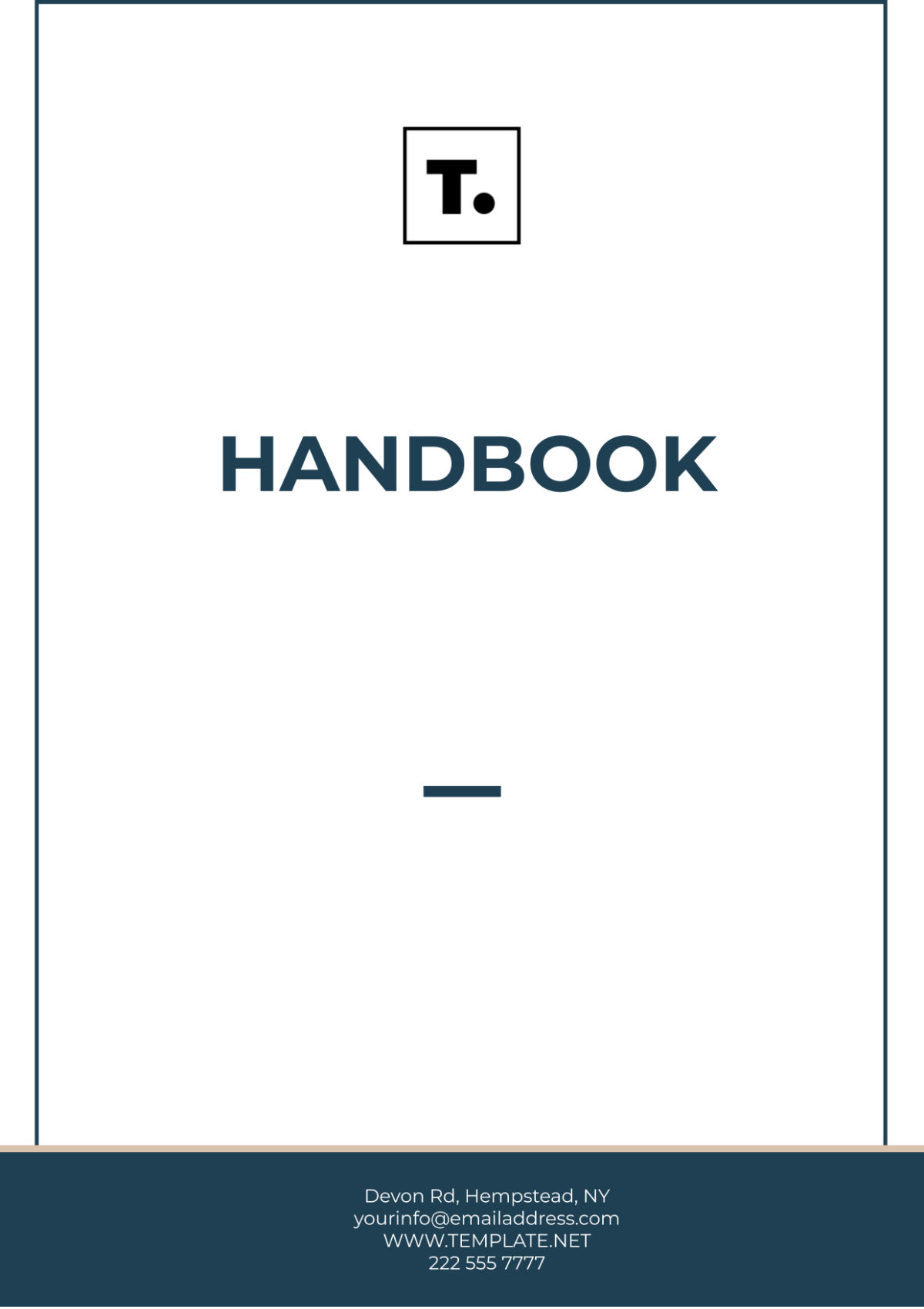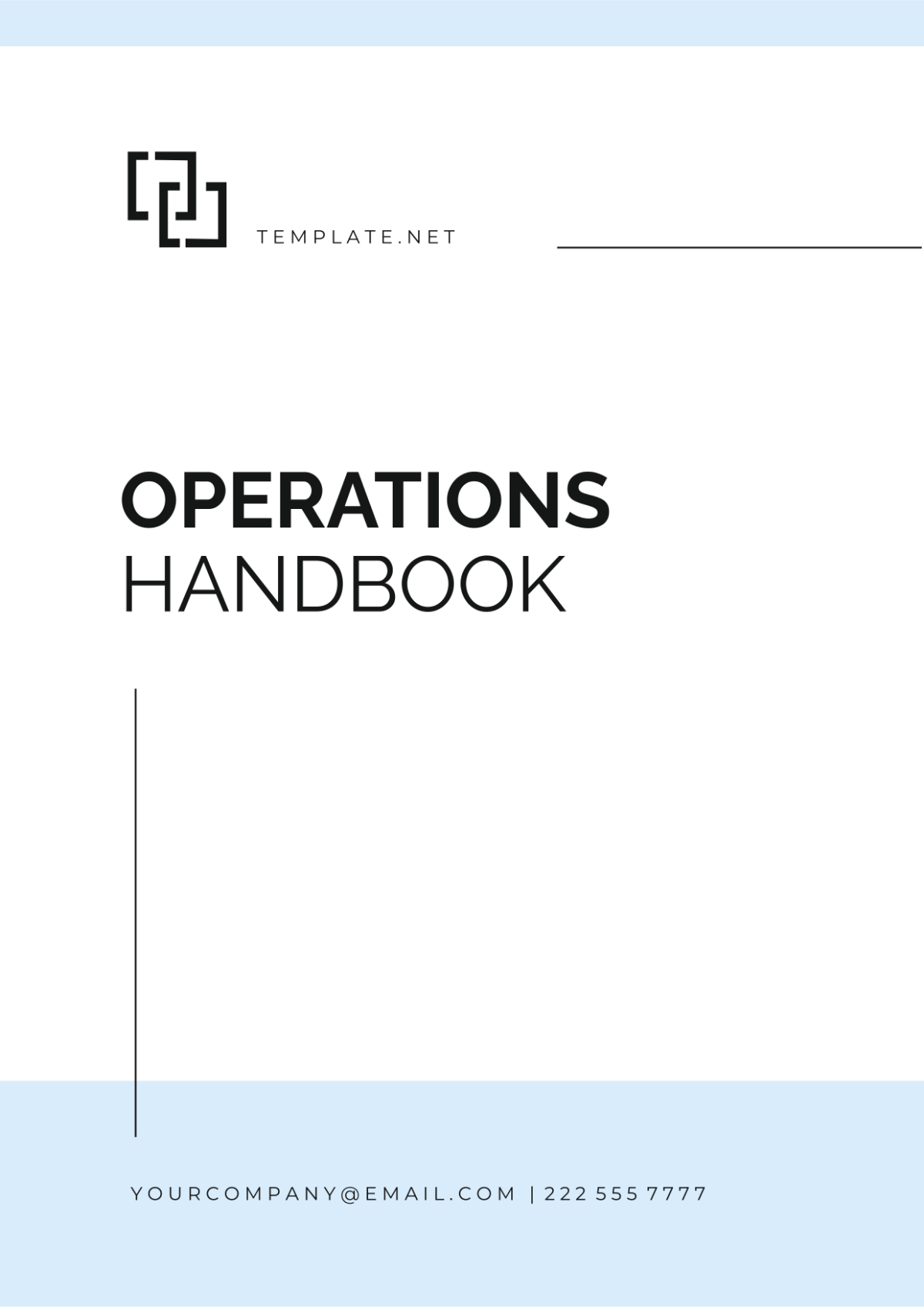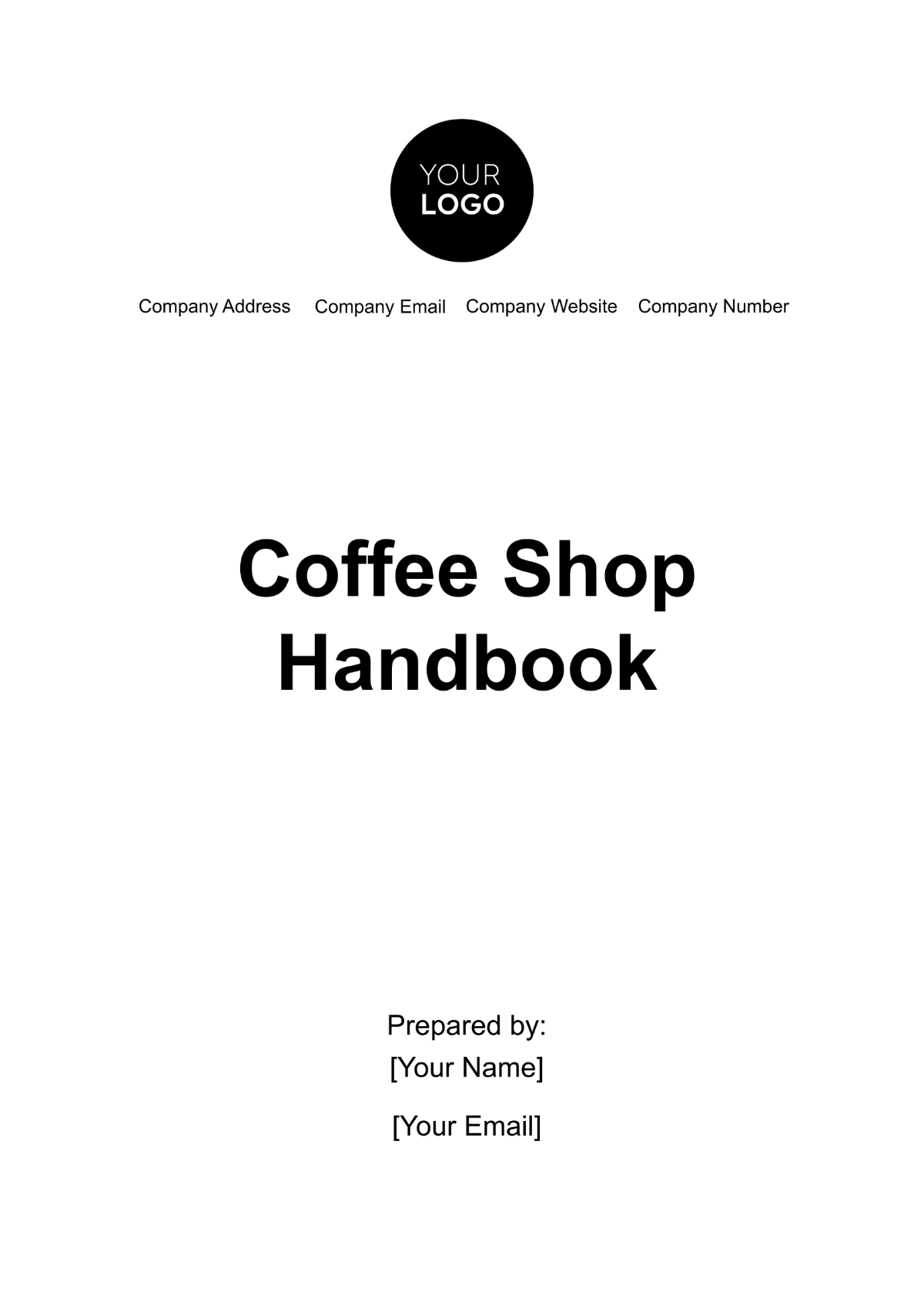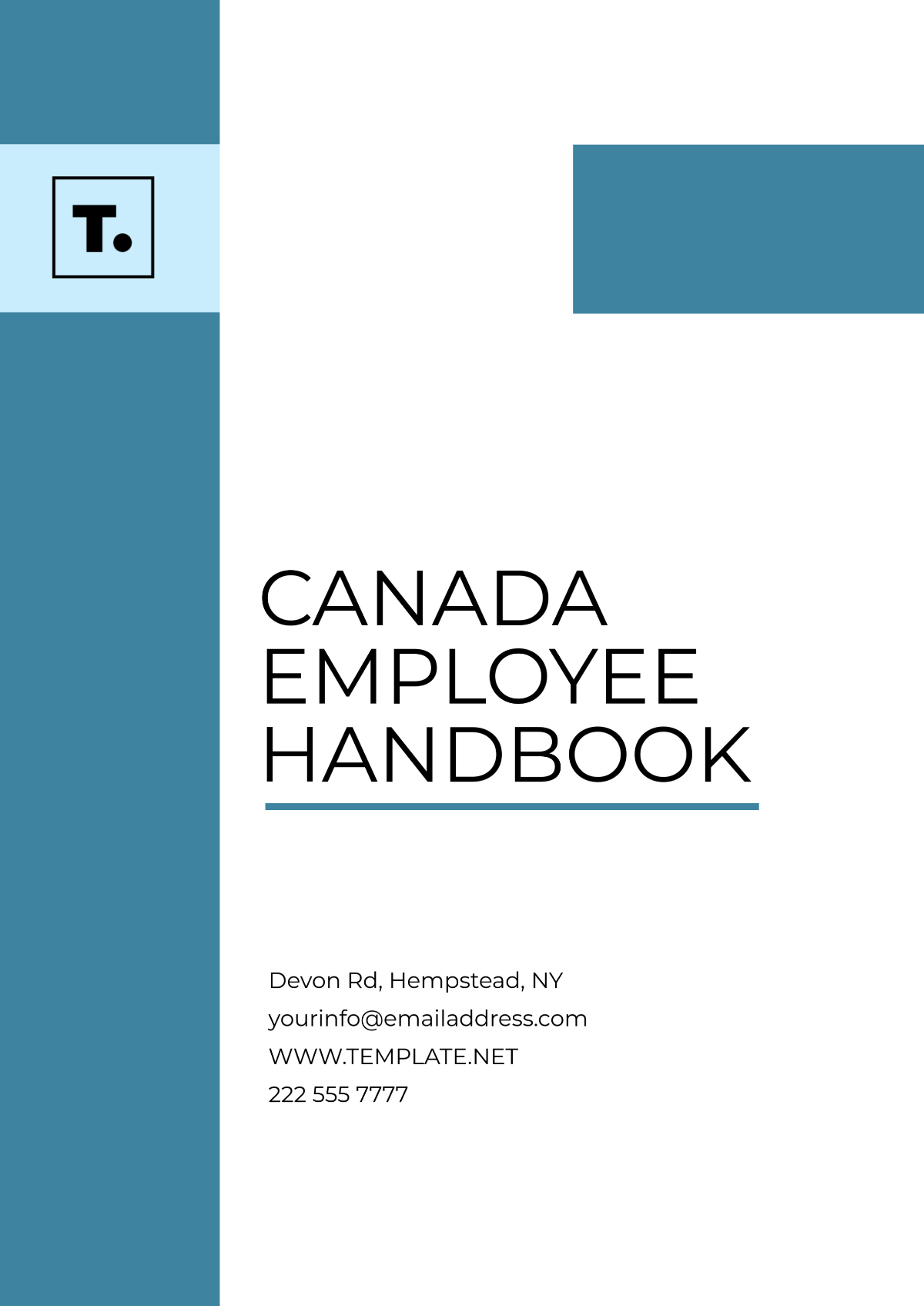Cafe Management Handbook
I. Introduction
A. Welcome Message
Welcome to [Your Company Name], where our mission is to cultivate an inviting, safe, and exceptional experience for both our valued customers and dedicated staff. This Cafe Management Handbook is an indispensable tool, meticulously designed to navigate you through the essential health and safety protocols, operational policies, and procedures that define our commitment to excellence. We believe that a well-informed team is the cornerstone of a successful and harmonious workplace.
Our Cafe Management Handbook is your comprehensive guide to mastering the daily operations of our cafe. It encompasses a wide array of topics, from stringent hygiene practices and emergency protocols to customer service standards and inventory management. By adhering to these guidelines, you will contribute to maintaining our high standards and ensuring a consistent and enjoyable experience for every patron. Your adherence to these practices is crucial to our shared success.
We expect every member of our team to read this handbook thoroughly and integrate its principles into your daily routines. It is more than a reference manual; it is a testament to our commitment to operational excellence and safety. Whenever questions or uncertainties arise, this handbook will be your first point of reference, providing clear and authoritative guidance. Thank you for your dedication and contribution to making [Your Company Name] a leader in the cafe industry.
B. Handbook Purpose
The purpose of the Cafe Management Handbook is to serve as a comprehensive guide that meticulously outlines all health and safety protocols, policies, and procedures within our cafe. It is designed to ensure that every employee is well-informed and consistently adheres to the necessary health and safety standards required to maintain a safe and efficient working environment. This handbook is a cornerstone of our commitment to operational excellence and the well-being of our team and customers.
In addition to health and safety standards, this handbook provides detailed instructions on emergency procedures, including evacuation routes and first aid protocols, to safeguard everyone in the event of an emergency. By familiarizing yourself with these procedures, you contribute to creating a secure environment where quick, informed actions can mitigate risks and ensure the safety of both staff and customers. This essential information empowers our team to respond effectively and confidently to any situation that may arise.
Moreover, the handbook covers the correct handling and storage of food items to prevent contamination and ensure food safety. By adhering to these guidelines, we uphold the highest standards of hygiene and quality, which are critical to our reputation and customer satisfaction. Regular updates to the handbook will keep it aligned with evolving health and safety regulations, ensuring that our practices remain current and compliant. This proactive approach reinforces our commitment to continuous improvement and operational excellence.
II. General Health and Safety Protocols
Ensuring the health and safety of our employees and customers is paramount at [Your Company Name]. This section of the Cafe Management Handbook outlines the fundamental health and safety protocols that every team member must follow. By adhering to these guidelines, we maintain a safe, hygienic, and efficient workplace, enhancing the overall experience for our patrons. Key areas include employee responsibilities and personal hygiene standards, detailed in the tables below.
A. Employee Responsibilities
All employees must adhere to the health and safety protocols, policies, and procedures outlined in this handbook. This table highlights key responsibilities that each team member is expected to uphold.
Responsibility | Description | Frequency |
|---|---|---|
Adherence to Protocols | Follow all health and safety protocols, policies, and procedures to ensure a safe and compliant workplace. | Daily |
Good Hygiene Practices | Consistently practice good personal hygiene, including washing hands and maintaining cleanliness to prevent the spread of germs and contamination. | Daily |
Reporting Concerns | Report any health or safety concerns, such as equipment malfunctions, potential hazards, or health issues, to supervisors immediately to ensure timely resolution. | As needed |
Training Participation | Attend regular training sessions and refresher courses on health and safety protocols to stay updated with the latest regulations and best practices. | As scheduled |
Incident Documentation | Document and report any incidents, no matter how minor, including slips, trips, falls, or near misses, to ensure proper recording and investigation. | Immediately after occurrence |
Workstation Cleanliness | Ensure workstations are clean, organized, and free from hazards, such as spills, clutter, and malfunctioning equipment, to maintain a safe working environment. | Continuous |
B. Personal Hygiene
Maintaining personal hygiene is crucial in a café setting to prevent the spread of germs and contamination. This table details the specific hygiene practices employees must follow.
Hygiene Practice | Description | Frequency |
|---|---|---|
Hand Washing | Wash hands thoroughly with soap and water for at least 20 seconds before and after handling food, using the restroom, or touching contaminated surfaces. | Before and after handling food |
Restroom Hygiene | Wash hands thoroughly after using the restroom to prevent the spread of bacteria and maintain personal and workplace hygiene. | After each restroom use |
Proper Attire | Wear clean uniforms, hairnets, or caps to ensure food safety and prevent contamination. | Daily |
Avoiding Face Touching | Avoid touching your face, mouth, or hair while working to reduce the risk of contamination. | Continuous |
Use of Sanitizers | Utilize hand sanitizers provided throughout the facility, especially after handling money, raw food, or any potentially contaminated items. | Frequent |
Handwashing Stations Utilization | Regularly use handwashing stations, especially after touching potentially contaminated surfaces, to ensure optimal hygiene standards are met. | Continuous |
By following these protocols, we ensure a safe, hygienic environment that meets the highest standards of health and safety, fostering trust and satisfaction among our customers and staff.
III. Food Safety and Handling
Maintaining impeccable food safety and handling standards is crucial for the health and satisfaction of our customers at [Your Company Name]. This section of the Cafe Management Handbook outlines essential practices for food storage and handling, ensuring we uphold the highest standards of hygiene and safety. By following these guidelines, we prevent contamination, reduce the risk of foodborne illnesses, and guarantee the freshness and quality of our food offerings.
A. Food Storage
Proper food storage is essential to maintain food safety and prevent contamination. This table details the protocols for storing different types of food items to ensure their safety and freshness.
Storage Type | Description | Frequency |
|---|---|---|
Refrigerated Items | Store all perishable items in refrigeration units at temperatures below 40°F (4°C). Monitor and record temperatures daily. | Daily |
Freezer Storage | Keep frozen items at or below 0°F (-18°C). Ensure that freezers are defrosted regularly to maintain efficiency. | Daily |
Dry Goods | Store dry goods in a cool, dry place away from direct sunlight. Ensure proper ventilation to prevent moisture buildup. | Weekly |
Cleaning Storage | Clean all storage areas regularly to prevent dirt and pests. Use food-safe cleaning agents and follow a strict schedule. | Weekly or as needed |
Inventory Rotation | Rotate inventory on a first-in, first-out (FIFO) basis to ensure older stock is used before newer stock. | Continuous |
Labeling Items | Label all stored items with the date of receipt and use-by dates to ensure proper tracking and usage. | Upon receipt and daily checks |
B. Handling and Preparation
Safe food handling practices are vital to prevent foodborne illness. This table provides detailed protocols for handling and preparing food safely.
Handling Practice | Description | Frequency |
|---|---|---|
Hand Washing | Wash hands thoroughly with soap and water for at least 20 seconds before and after handling food. | Before and after handling food |
Use of Gloves | Wear gloves when handling ready-to-eat foods and change them regularly to prevent cross-contamination. | Continuous |
Separate Equipment | Use separate cutting boards and utensils for raw and cooked foods to avoid cross-contamination. | Continuous |
Cooking Temperatures | Cook food to the correct internal temperatures to ensure it is safe to eat. Refer to the temperature guide. | Each cooking process |
Food Labeling | Label all prepared food items with preparation dates and times to ensure they are used within safe periods. | Upon preparation |
Equipment Sanitation | Sanitize all kitchen equipment and surfaces after use to prevent contamination. | After each use |
By adhering to these protocols, we ensure that our food handling and preparation processes meet the highest standards of safety and hygiene, safeguarding the health of our customers and staff.
IV. Equipment Safety
Ensuring the safety and efficiency of our equipment is critical to maintaining a productive and hazard-free environment at [Your Company Name]. This section of the Cafe Management Handbook provides detailed guidelines on the safe operation and maintenance of all equipment used in our café. By adhering to these protocols, we minimize risks, ensure compliance with safety standards, and promote the longevity and reliability of our equipment.
A. Operation Guidelines
Each piece of equipment in the café must be used according to the manufacturer’s guidelines. This table outlines the key operation guidelines for safely using café equipment.
Operation Guideline | Description | Frequency |
|---|---|---|
Manufacturer’s Instructions | Follow the manufacturer’s guidelines for the operation of each piece of equipment to ensure proper usage. | Every use |
Employee Training | Provide thorough training on the use and maintenance of all equipment employees are expected to operate. | Upon hiring and as needed |
Regular Inspections | Conduct regular inspections to ensure that all equipment is in good working condition. | Weekly |
Reporting Malfunctions | Report any malfunctions or defects immediately to a supervisor to prevent accidents and equipment damage. | As soon as detected |
Lockout/Tagout Procedures | Follow proper lockout/tagout procedures during equipment cleaning and maintenance to prevent accidental startup. | Every maintenance and cleaning task |
B. Cleaning and Maintenance
Routine cleaning and maintenance of equipment ensure smooth operations and prevent accidents. This table provides a comprehensive schedule and procedures for cleaning and maintaining café equipment.
Cleaning and Maintenance Task | Description | Frequency |
|---|---|---|
Daily Cleaning | Perform daily cleaning of equipment surfaces and components to remove food residue and prevent buildup. | Daily after each use |
Weekly Deep Cleaning | Conduct deep cleaning to remove any accumulated residue or hidden contaminants as per manufacturer’s instructions. | Weekly |
Maintenance Logs | Keep detailed maintenance logs documenting all cleaning and repairs performed on equipment. | Continuous |
Inspection and Repair Reporting | Inspect equipment regularly and report any broken or damaged items. Remove from service until repairs are completed. | Weekly or as needed |
Manufacturer's Maintenance Schedule | Follow the manufacturer’s maintenance schedule for specific tasks such as oiling, calibration, and part replacement. | As per manufacturer's guidelines |
By adhering to these equipment safety protocols, we ensure that all equipment is used and maintained correctly, minimizing risks and promoting a safe, efficient working environment for our staff and customers.
V. Emergency Procedures
Being prepared for emergencies is essential for ensuring the safety and well-being of our employees and customers at [Your Company Name]. This section of the Cafe Management Handbook outlines critical procedures for evacuations and first aid response. By familiarizing ourselves with these protocols and conducting regular drills, we can efficiently manage emergencies and minimize risks.
A. Evacuation Routes
In the event of an emergency requiring evacuation, employees must be aware of all designated evacuation routes and exits. This table outlines key guidelines for safe and efficient evacuation procedures.
Evacuation Guideline | Description | Frequency |
|---|---|---|
Awareness of Evacuation Routes | Employees must be familiar with all designated evacuation routes and exits. | Continuous |
Display of Evacuation Maps | Maps of evacuation routes should be displayed prominently in key areas around the café. | Permanent |
Conducting Regular Drills | Regular drills will be conducted to ensure all employees are familiar with evacuation procedures. | Quarterly |
Assisting Customers | Employees should assist customers in evacuating the premises quickly and safely. | During each evacuation |
Assembly Point Protocol | After evacuation, employees must gather at the designated assembly point for a headcount and further instructions. | During each evacuation |
B. First Aid Protocols
Having well-defined first aid protocols in place is essential for handling minor injuries and emergencies. This table details the necessary steps for effective first aid response.
First Aid Protocol | Description | Frequency |
|---|---|---|
Familiarity with First Aid Kits | All employees should know the location of first aid kits and how to use them. | Continuous |
Posting of Trained Responders | A list of trained first aid responders should be posted in the staff area for quick reference during emergencies. | Permanent |
Emergency Services Contact | In the event of a serious injury, employees must call emergency services immediately. | As needed |
Incident Reporting | Detailed reports of all incidents should be completed and submitted to management for review and follow-up. | Immediately after occurrence |
Regular First Aid Training | Employees should undergo regular first aid training to stay updated on the latest procedures and protocols. | Annually or as required |
By adhering to these emergency procedures, we ensure that our team is well-prepared to handle emergencies effectively, safeguarding the health and safety of everyone in the café.
VI. Policy Updates and Communication
Keeping our policies current and maintaining clear communication is crucial for ensuring the safety and well-being of our employees and customers at [Your Company Name]. This section of the Cafe Management Handbook outlines the procedures for regular policy updates and effective communication strategies. By staying informed and engaged, we can continuously improve our health and safety standards.
A. Regular Updates
The Cafe Management Handbook will be reviewed and updated regularly to reflect any changes in health and safety regulations. This table outlines the procedures for managing and communicating these updates.
Update Procedure | Description | Frequency |
|---|---|---|
Handbook Review and Update | Regular review and update of the handbook to incorporate changes in health and safety regulations. | Quarterly |
Employee Notification | Notifying employees of any updates and providing training to understand new protocols. | As updates occur |
Acknowledgment of Revisions | All staff members must read and acknowledge any revisions to the handbook. | Upon distribution of updates |
Distribution of Updated Handbook | Hard copies of the updated handbook will be distributed, and a digital version will be accessible on the company website. | Upon completion of updates |
Encouragement of Feedback | Feedback from employees regarding the handbook is encouraged and will be considered during the review process. | Continuous |
B. Communication
Effective communication is key to maintaining a safe working environment. This table details the communication protocols to ensure that all health and safety information is clearly conveyed.
Communication Protocol | Description | Frequency |
|---|---|---|
Reporting Health and Safety Concerns | Employees are encouraged to report any health or safety concerns to their supervisors immediately. | As needed |
Regular Staff Meetings | Regular staff meetings will be held to discuss any issues or updates regarding health and safety protocols. | Monthly |
Clear Communication from Management | Management will ensure that all communication regarding safety procedures is clear and easily understood. | Continuous |
Open-Door Policy | An open-door policy is in place, allowing employees to voice their concerns without fear of reprisal. | Continuous |
By adhering to these policy update and communication protocols, we ensure that all employees are well-informed, engaged, and proactive in maintaining a safe and compliant working environment.
VII. Conclusion
The Cafe Management Handbook serves as a cornerstone for ensuring the health and safety of everyone involved in our café operations. By diligently following the protocols, policies, and procedures outlined within this document, we establish and maintain a safe and pleasant working environment for both employees and customers alike. It is incumbent upon each team member to thoroughly familiarize themselves with the handbook and strictly adhere to its guidelines to uphold our commitment to safety.
Management is fully dedicated to providing continuous support and training to ensure that these standards are not only met but exceeded. We understand that upholding these standards is a collective effort, and through collaboration and dedication, we can create a café that prioritizes health and safety above all else. Together, we can ensure that our café remains a safe, welcoming, and enjoyable place for everyone.
Thus, the Cafe Management Handbook is a fundamental tool that guides us in maintaining the highest standards of health and safety. It is a reflection of our commitment to the well-being of our employees and customers. Let us all embrace this responsibility with diligence and dedication, knowing that by doing so, we contribute to a safer and more enjoyable café experience for everyone.
Revision History
Revision Date | Revised By | Summary of Changes |
|---|---|---|
[Revision Date] | [Your Name] | Initial creation of the handbook. |
[Revision Date] | [Your Name] | Updated food handling procedures to comply with new regulations. |

















































